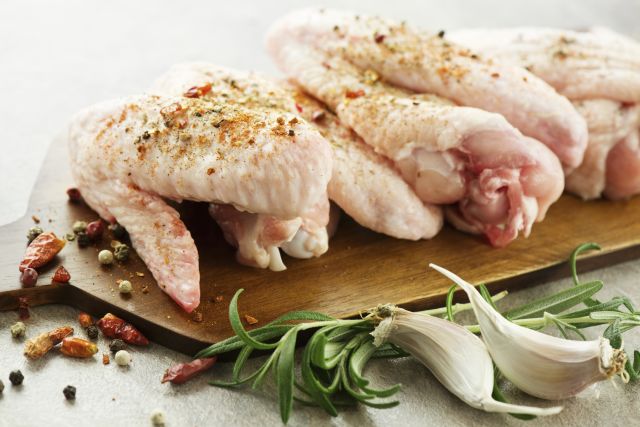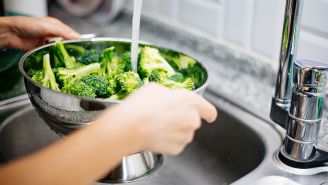Updated on April 24, 2024.
Are you planning to have E. coli, salmonella, campylobacter, listeria, or cyclospora for dinner? These are just a few of the hundreds of organisms that could be hiding on your plate and putting you at risk of foodborne illness.
As many as 76 million people in the United States develop foodborne illnesses each year, so it's wise to take measures to keep these uninvited guests from spoiling your meals. Surprisingly, your risk of contamination may be greatest when cooking at home rather than when eating out.
How careful are you when it comes to handling food? Take this quick quiz to find out.
Be smart with produce
Question: While making a salad for her family, Karina discards the outer layers of the head of lettuce and rinses it under water, washes the cherry tomatoes, and peels and slices the cucumber on a clean cutting board. Has Karina followed all of the proper food preparation steps to protect her family from foodborne illnesses?
Answer: No.
Karina is on the right track but she did miss a step. Any bacteria on the outside of the cucumber can be transferred, via the knife, to the inside when the cucumber is peeled or cut, so it must be washed first.
Contrary to popular belief, your biggest health threat may not come from the herbicides, pesticides, and other synthetic chemicals found on the peel or rind of produce. Instead, you're more likely to get sick from the naturally occurring, disease-producing organisms that can cling to the outside of produce. Any foods that come in contact with dirt or manure will contain a certain number of microorganisms. And any foods that are handled by people can likewise become contaminated.
Always thoroughly rinse vegetables and fruits—such as squashes, cucumbers, cantaloupe, and other melons—that you plan to peel or cut. Use running water rather than a bowl of water.
If you prefer to eat the peel, scrub the produce with a stiff vegetable brush to remove dirt and wash thoroughly to remove bacteria. Scrubbing with vinegar will strip off the wax coatings found on veggies such as cucumbers and some apples. And don't forget to cut away any bruises.
Prepare meat carefully
Question: Shelly is making a batch of meatballs for a party. Which of the following is the safest type of ground beef?
- Prepackaged, lean ground sirloin, fresh not frozen
- Top round steak, freshly ground at the store
- Ground chuck patties, frozen not fresh
Answer: Top round steak, freshly ground at the store.
If Shelly wants to be really safe, she should select a piece of steak and ask to have it ground into hamburger meat while she waits. Freshly ground beef or poultry is less likely to harbor high amounts of bacteria than older ground meat. You also can purchase whole cuts of meat and grind it yourself at home in a food processor or meat grinder. A single hamburger sold in a package, on the other hand, may contain meat from hundreds of different cows.
Regardless of which type of ground beef you choose, you can kill virtually all bacteria by cooking the meat to 160°F. Bacteria are commonly found in raw hamburger.
When preparing ground beef, take away the guesswork by using a thermometer to check the internal temperature of the meat. This will prevent food poisoning from bacteria such as E. coli. When reheating, internal temperatures should reach 165°F.
Recycle with an eye to food safety
Question: Which environmentally friendly task should Brian discontinue for health reasons?
- Separating his plastic and paper refuse from the rest of his trash for recycling
- Reusing his paper bags each week at the farmer's market
- Placing his coffee grounds in the compost pile
Answer: Reusing his paper bags each week at the farmer's market.
Brian shouldn't reuse his paper bags each week at the farmer's market because old grocery bags or packaging materials may be contaminated from food previously stored in them. When given the chance, microbes that cause food poisoning will latch onto any new foods that they encounter. Instead, use cloth grocery sacks that you can wash in hot water on a regular basis.
Also, when you are bagging your groceries, keep meat and other raw animal products separated from other groceries, particularly fruits and vegetables. Fruits and vegetables can become cross-contaminated by coming into contact with raw meats, poultry, and seafood. Store food only in food-grade containers or packaging materials. Garbage bags and certain other non-grocery containers may be treated with chemicals and mold inhibitors that are not safe for consumption.
Be wary of leftovers
Question: After her party, Linda throws away the dip from the vegetable platter, but enjoys munching on the leftover baby carrots and celery sticks. Has Linda put herself at risk for a long night of an upset stomach?
Answer: Yes.
By eating those veggies, Linda is at risk of gastroenteritis. Cutting or peeling fruit and vegetables is equivalent to breaking the seal on a container. Once that seal is broken, bacteria will begin to grow on the cut or peeled surface of the vegetable.
In small quantities, bacteria typically won't cause problems, but because bacteria multiply rapidly when temperatures are between 40°F and 140°F, never trust any cut produce that has been left out for more than two hours (or one hour in warm weather). That includes items such as fresh salsa and freshly chopped herbs such as cilantro or basil.
Most people don't measure their refrigerator temperature and don't know what it should be.To inhibit the growth of most bacteria on cut produce and other foods, the internal temperature of your fridge should always stay below 40°F (5°C). Putting large containers of hot food directly into the fridge or freezer before it has sufficiently cooled can disrupt the temperature within the refrigerator and increase the risk of rapid bacterial growth for all foods. Instead, divide hot leftovers into smaller portions in shallow containers so they can cool down as quickly as possible.
When the time comes to eat these leftovers, remember that the sniff test isn't a reliable way of checking the safety. Bacteria that cause food-borne illness do not always cause bad tastes and odors in food. A safer rule of thumb is to discard any leftovers that are more than three days old or that have not been properly stored or refrigerated.
Defrost and refreeze with care
Question: Chris doesn't have time to cook the fish that he has been defrosting in the refrigerator for almost two days. What should he do?
- Throw it away
- Keep it thawed until he has time to prepare and eat it
- Put it back in the freezer
Answer: Put it back in the freezer.
It's safe for Chris to refreeze fish, poultry, and meat as long as they were defrosted in the refrigerator and not in the microwave or at room temperature. If the food was thawed out of the fridge or in the microwave, on the other hand, do not refreeze it.
Because seafood is a common source of food-borne illness, it's wise to be cautious when buying and preparing fish. Thoroughly cook all foods, but be particularly careful with oysters, clams, or mussles, which carry the greatest health risks from undercooking.
If you're making sushi, buy seafood from reputable sources and store it in the coldest part of the refrigerator, usually under the freezer compartment or in a special meat drawer. Avoid packing it in tightly with other items to allow air to circulate freely around the package.
You can never be too safe
Although the food industry and regulatory agencies have effective surveillance and investigative methods, you cannot rely on only these systems to keep your food safe. Think of proper food handling as wearing a seatbelt. Because you never know when you are going to encounter dangerous foodborne pathogens, treat all foods as if they may contain them.
Thoroughly cooking food, storing it at appropriate temperatures, preventing cross-contamination from meats and poultry to other foods, and keeping hands, tools, and kitchen surfaces sanitized can help keep a few bacteria from growing to a dangerously high number of pathogens.







